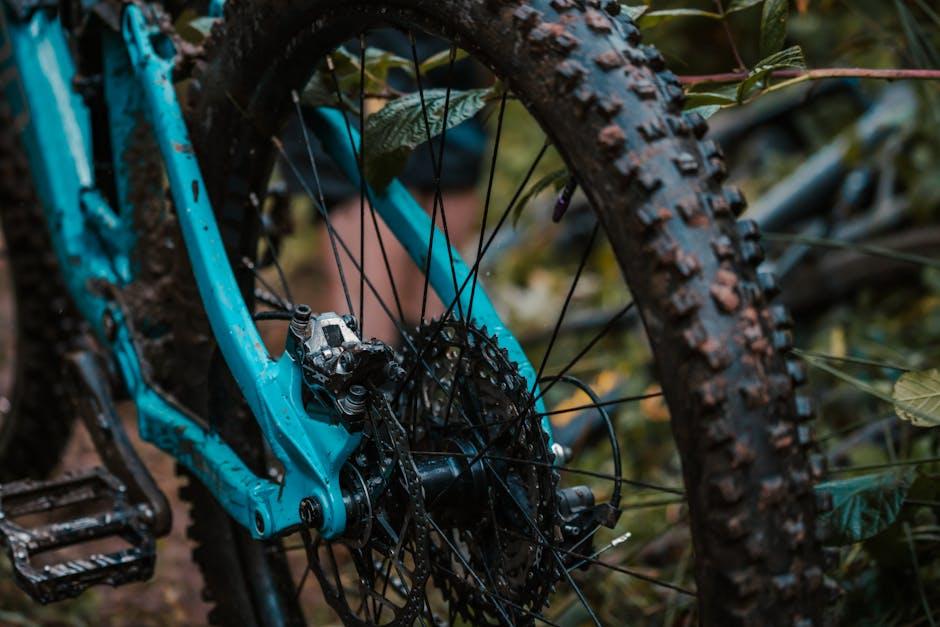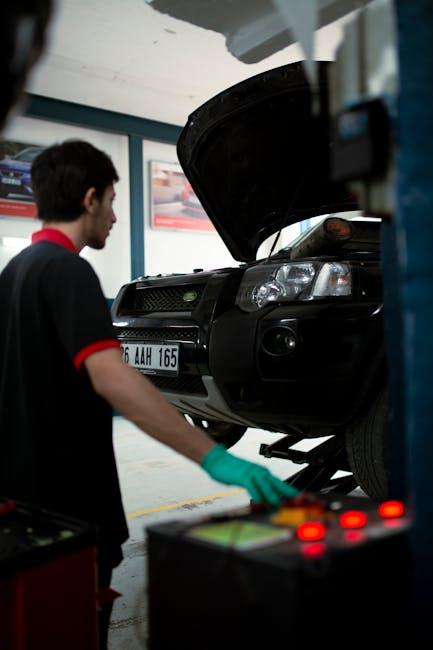Brakes are the unsung heroes of every journey—silent sentinels that stop us safely when it matters most. Yet, despite their critical role, brake problems can sneak up on even the most vigilant driver, turning routine stops into nerve-wracking moments. From subtle squeaks to unexpected vibrations, the signs of brake trouble are as varied as the causes behind them. In this article, we’ll unravel the most common brake problems, demystifying the noises, sensations, and warning signs that signal it’s time to take a closer look. Whether you’re a seasoned driver or a new car owner, understanding these issues can keep your rides smooth and safe, mile after mile.
Table of Contents
- Understanding the Signs of Brake Wear and Tear
- Decoding Unusual Noises and What They Mean for Your Brakes
- The Impact of Brake Fluid Quality on Stopping Power
- How to Identify and Fix Brake Pedal Issues Safely
- Exploring the Causes and Solutions for Brake Vibration
- Routine Maintenance Tips to Extend Brake System Life
- Q&A
- Insights and Conclusions

Understanding the Signs of Brake Wear and Tear
Recognizing when your brakes are starting to show signs of wear is crucial for maintaining vehicle safety and avoiding costly repairs. Some of the most common indicators include a
Here are some tell-tale signs you shouldn’t ignore:
- High-pitched screeching: Early warning of brake pad wear
- Grinding sound: Metal-on-metal contact indicating severe wear
- Brake pedal softness: Possible fluid leaks or air in the system
- Steering wheel vibration: Likely warped rotors or uneven wear
- Warning light on dashboard: Sensor alert for brake issues
| Symptom | Probable Cause | Recommended Action |
|---|---|---|
| Squealing noise | Worn brake pads | Replace brake pads promptly |
| Soft brake pedal | Brake fluid leak or air in lines | Check and bleed brake system |
| Vibration when braking | Warped rotors | Resurface or replace rotors |

Decoding Unusual Noises and What They Mean for Your Brakes
When your brakes start making unusual noises, it’s a clear signal your vehicle is trying to communicate. A squealing sound often points to worn brake pads that need replacing soon, while a grinding noise is more serious and usually means the brake pads are completely worn out, exposing the metal beneath and potentially damaging the rotors. Another common culprit is a chirping or clicking noise, which could indicate foreign objects like small stones caught in the brake components or a loose backing plate. Even a thumping sound under braking might reveal misaligned or warped rotors demanding immediate attention.
Here’s a quick guide to help you decode these noises and understand their implications:
| Noise Type | Possible Cause | Action |
|---|---|---|
| Squealing | Worn brake pads | Check and replace pads |
| Grinding | Metal-on-metal contact | Replace pads & inspect rotors |
| Clicking/Chirping | Debris or loose parts | Clean & tighten components |
| Thumping | Warped rotors | Resurface or replace rotors |

The Impact of Brake Fluid Quality on Stopping Power
Brake fluid is more than just a filler in your braking system; it’s the lifeblood that translates pedal pressure into the force required to stop your vehicle effectively. Over time, fluid quality can degrade due to moisture absorption, contamination, or improper maintenance. Low-quality or contaminated brake fluid can lead to a spongy brake pedal, reduced hydraulic pressure, and ultimately longer stopping distances, putting you at risk in critical situations. Understanding and maintaining the purity of your brake fluid is essential to ensure peak stopping power and overall brake system health.
Regular brake fluid checks and changes can prevent common issues such as:
- Corrosion: Moisture in brake fluid can corrode brake lines and components, leading to leaks or failures.
- Boiling Point Reduction: Old or contaminated fluid has a lower boiling point, causing vapor lock and brake fade during heavy braking.
- Inconsistent Brake Feel: Degraded fluid causes fluctuations in pedal firmness, making braking unpredictable.
| Brake Fluid Quality | Impact on Stopping Power |
|---|---|
| New & Clean | Optimal pressure and response |
| Moisture Contaminated | Reduced boiling point, brake fade risk |
| Old & Neglected | Spongy pedal, longer stopping distances |

How to Identify and Fix Brake Pedal Issues Safely
Recognizing the signs of an unresponsive or spongy brake pedal is crucial for your safety on the road. Common symptoms include a pedal that sinks to the floor, requires excessive force to engage, or feels unusually soft. These issues often point to problems such as air trapped in the brake lines, low brake fluid levels, or worn brake components. Before attempting any repairs, ensure the vehicle is on level ground and the engine is off. Always wear protective gloves and eye protection to avoid contact with brake fluid, which is corrosive. Using a flashlight, check under the dashboard and around the pedal assembly for any visible damage or leaks.
Once you’ve identified a possible cause, here are some safe steps to troubleshoot and fix the issue:
- Brake Fluid Check: Inspect the master cylinder reservoir and top it up if fluid is low, using the correct fluid type specified by your vehicle’s manual.
- Bleeding Brakes: Remove air bubbles by bleeding the brake lines using proper tools or seek professional help if unfamiliar with the process.
- Component Inspection: Examine brake pads, discs, and lines for wear or damage, replacing any faulty parts promptly.
| Issue | Probable Cause | Fix |
|---|---|---|
| Soft Pedal | Air in Brake Lines | Brake Bleeding |
| Pedal Sinks | Master Cylinder Leak | Replace Cylinder |
| Hard Pedal | Vacuum Leak | Inspect Vacuum Lines |

Exploring the Causes and Solutions for Brake Vibration
Brake vibration most often signals an underlying mechanical issue that, if left untreated, can affect both safety and driving comfort. Common culprits include warped rotors, which create uneven friction surfaces causing pulsation during braking, and loosely mounted brake components that exacerbate the shaking. Additionally, contaminated brake pads or caliper malfunctions can induce similar symptoms, making it essential to diagnose the root cause carefully rather than assuming a simple fix.
Addressing brake vibration involves a combination of inspection, repair, and sometimes replacement. Here’s a quick guide to the most effective solutions:
- Rotor resurfacing or replacement: Ensures even contact between pads and rotors
- Brake pad replacement: Especially if the pads are uneven or contaminated
- Caliper servicing: Includes cleaning, lubricating, or replacing stuck calipers
- Wheel bearing and suspension check: To rule out related vibration causes
| Cause | Solution | Estimated Cost |
|---|---|---|
| Warped Rotors | Resurfacing or Replacement | $50 – $150 per rotor |
| Worn Pads | Replacement | $40 – $120 |
| Sticking Calipers | Cleaning or Replacing | $70 – $200 |

Routine Maintenance Tips to Extend Brake System Life
Consistently caring for your brake system not only ensures safety but also dramatically extends the life of its components. Start by checking brake fluid levels monthly; low fluid can cause spongy brake pedals or complete brake failure. Additionally, listen closely for unusual noises like squealing or grinding, which often indicate worn pads or debris caught in the braking mechanism. Replacing brake pads before they’re completely worn prevents damage to rotors, saving you from costly repairs.
Incorporate these simple habits to keep your brakes in optimal condition:
- Routine inspection: Have a professional inspect the entire brake system at least once a year.
- Clean regularly: Remove dust and debris from brake components using a soft brush or compressed air.
- Avoid harsh braking: Gradual slowing reduces wear and heat buildup.
- Check tire pressure: Properly inflated tires ensure balanced braking pressure.
| Maintenance Task | Recommended Frequency | Key Benefit |
|---|---|---|
| Brake fluid level check | Monthly | Prevents hydraulic failure |
| Brake pad inspection | Every 6 months | Avoids rotor damage |
| Brake system cleaning | Every 12 months | Removes dust and grit buildup |
Q&A
Q&A: Common Brake Problems Explained
Q1: Why does my brake pedal feel spongy when I press it?
A1: A spongy brake pedal often signals air trapped in the brake lines or deteriorated brake fluid. Air compresses under pressure, making the pedal feel soft, while old fluid can absorb moisture, reducing braking efficiency. Bleeding the brakes and replacing fluid usually restores firmness.
Q2: What causes my car to squeal when I brake?
A2: Squealing brakes are usually a warning sign from worn brake pads. Many pads have built-in wear indicators that emit a high-pitched sound to alert you before the pads wear too thin. Sometimes, glazed pads or dust can also cause noise. Timely replacement avoids damaging rotors.
Q3: Why does my car pull to one side during braking?
A3: Uneven braking typically results from stuck calipers, uneven pad wear, or issues with the brake hose. If one side’s brakes are stronger or engaging differently, your car will veer toward the opposite side. This can be dangerous and needs prompt inspection.
Q4: What leads to vibrations or pulsations felt in the brake pedal?
A4: Vibrations during braking often point to warped brake rotors. Heat buildup and uneven wear cause rotor surfaces to lose smoothness, generating a pulsing sensation in the pedal. Resurfacing or replacing rotors usually fixes this issue.
Q5: My brakes are making a grinding sound—what’s wrong?
A5: Grinding sounds usually mean your brake pads are completely worn down, causing metal-to-metal contact with the rotor. This can severely damage braking components and compromise safety. Immediate brake service is critical to prevent costly repairs.
Q6: Why do my brakes feel less effective in wet conditions?
A6: Moisture on rotors reduces friction temporarily, leading to a “spongy” or less responsive brake feel. This is normal but should improve after a few presses of the pedal. However, if braking remains weak, it might indicate worn parts or fluid issues requiring attention.
Q7: Can brake problems affect my vehicle’s fuel efficiency?
A7: Yes. Sticky calipers or dragging brakes increase resistance, forcing your engine to work harder and consume more fuel. Keeping your braking system in good condition not only ensures safety but also supports better fuel economy.
Q8: How often should I have my brakes inspected?
A8: Regular inspections every 10,000 to 15,000 miles help catch brake issues early. However, if you notice noises, reduced braking power, or unusual pedal feel, don’t wait—get a professional check immediately.
This Q&A shines a light on the most common brake problems drivers encounter, explaining why they happen and what you can do to keep your car stopping safely.
Insights and Conclusions
Understanding the intricacies of your vehicle’s braking system is more than just a matter of maintenance—it’s a cornerstone of safety and confidence on the road. By recognizing common brake problems early, you not only extend the life of your car but also ensure peace of mind every time you press the pedal. Remember, a smooth stop is the culmination of care, attention, and timely fixes. So next time your brakes whisper a warning, listen closely—it’s your vehicle’s way of asking for a little TLC. After all, every journey deserves a safe ending.

